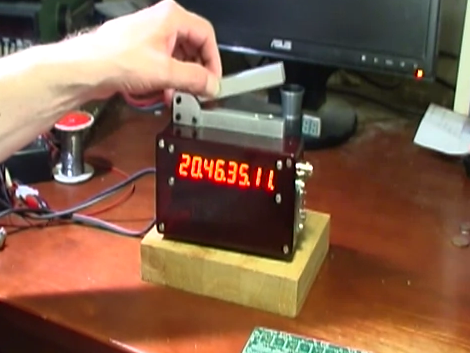
Whether you know it as a clapperboard, a slate, slate board, time slate, or by another name, you probably recognize this staple of movie making. It’s a handy way to help synchronize sound with video, and to keep track of clips when it comes time to edit. But this clapperboard is quite a bit more accurate than most. It’s got an atomic clock source for dead-on accuracy.
The project came from the growing availability of Rubidium clock source modules on eBay. They can be had for under $100 and you’ll enjoy accuracy of 0.1 ppm. [Luddite Tech] grabbed one for himself and included it in this build. As you can see in the clip after the break, the contrast of the eight-digit display is adjustable, and shines brightest when the marker is snapped. We’d guess the cable he connects at the beginning of the demo is used to set the initial time reference. After that the in-built WiFi can be used to push the time markers to a computer.
[Thanks Kevin]















I don’t see why a clapperboard needs a time readout at all, its just to sync the video and audio as you said, but the switch could be put into a door with a webcam to take a picture and record the exact time of people coming and going, now that could use an accurate time.
I’m not in film, but having a time readout that corresponded to my audio gear would seem like a handy thing to have.
Multiple cameras, multiple clapboards. That’s why it needs a time readout.
Yay!! you got my tip :)
what’s the point in having an atomic clock? there will be an error of orders of magnitude greater introduced by the lag between the moment the marker is snapped and the moment the sound reaches the microphone (and processed by the ADC and written in memory)
That’s the whole point: To have a single reference point from which to compensate for all these lags.
Not sure I get it … They have another equally precise clock, synchronized with the one on the clapperboard, which records timestamps on the audio and video track?
jboogie, yes. The audio recorder, camera, and clapper board each have equally precise clocks that either get synced at the beginning of the day or each is connected together making a network and one device (usually the camera) is the master clock.
To expand what milo said: http://en.wikipedia.org/wiki/SMPTE_time_code#Studio_operations_and_master_clocks
That said, you both are missing the point.
Clapperboards with time display are used when you don’t have any other timecode. In this case the picture of the time display and the sound of the snap are the timestamps you were speculating about – they serve (much more rudimentarily) the same purpose as SMPTE TC would. Think about it. Of course if you have many cameras and thus many clapboards you do need all the clapboards to be precisely synchronized.
If you do have SMPTE then you don’t need any time display at all (it’s redundant), a simple clapper board without time will do.
If you have modern equipment you don’t even need that. These days you just fill in the metadata. The only thing the clap does is indicate “start acting now” to the guys on scene and may as well be an actual clap with your hands. Carrying a clapperboard around is for nostalgics and poor people with non-synchronizable equipment.
(Not that it detracts from the build)
I make this little gadget, it’s NOT driven by an atomic clock, I use the atomic clock to calibrate the crystal oscillators on the main circuit board, to maintain an accuracy of better than 2 parts per million, about 4 video frames per day.
I’m not sure I understand crystals enough, but I thought the problem is that they drift from small temperature changes, so unless the atomic clock source is hooked up to each one all day they will experience varying drift. So even if they were synced at the beginning of the day, by the end they could all be out of whack. No?
I can’t help but notice the audio is out of sync. :P
Generally, the slate is jammed/sync’d with the audio recorder’s time code, then the slate is taken to the camera and sync’d with it, so that they all match. This hack is great if the other components are sync’d to Atomic Time, otherwise they need to be for this to be truly effective.